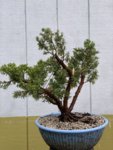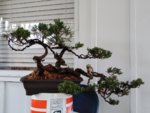Don't go crazy with juniper repotting on the first round. They are particularly sensitive to having their roots cut. If you are moving a juniper from a nursery pot into pre-bonsai soil, I would recommend using something like an Anderson flat and just tease out the juniper roots and spread them out without trimming them (unless they are like 24" long). Do not wash them either. I may just be superstitious or paranoid, but I believe that early on keeping the roots dirty and "non-stressed" is important to successfully transitioning them into bonsai culture. Once they are growing strongly in good bonsai soil, you can be more aggressive with repotting.
Take it from the guy who is the master juniper killer

I have killed junipers in more ways than you can imagine. Now however I actually make more than I kill



